Becky Clark's Blog, page 10
February 22, 2021
Can you believe I opened THIS can of worms?
I opened my wormy can in a Facebook group by asking some cozy mystery readers which tropes they hated.
It was a tad disingenuous on my part because I had just finished the first draft of a manuscript and was getting ready to do a revision. Not that I was pandering or trying to write by committee, mind you, but if everyone hated a certain thing, and I had a chance to not do that certain thing, well, I’d be foolish not to listen, right? Right?
Well, listen I did. For a long, long time because these readers had loud and proud opinions!
love triangle (I lost count at all the people who agreed and expounded on this. It was far and away the biggest gripe)business owners closing their store to chase clues (second biggest gripe)more job-related gripes include the sleuth having a specialty job she doesn’t know how to do; having a job they never go to; the character gets dumped by boyfriend and moves home to start a businesstoo perfect an ending“she got out of a bad relationship and inherited a fortune”sleuth accidentally stumbles on the solutionauthor doesn’t play fair with the cluessleuth puts herself in danger because she doesn’t think it throughand there were opinions about law enforcement … some people don’t like the cops to be inept or jerks; “I don’t care what the police say, I’m doing it!”; sleuths who talk about how they solved previous crimes, like the police did nothing; characters who sleuth because the police aren’t doing enough; characters (or authors) who know nothing about the lawAnd there were more. So many more. I got disheartened and gave up when I saw that over the course of my books I’ve done, oh, most everything they hated.
Except the love triangle.
So I’ve got that going for me.
Can you believe I was so stupid to ask this?? I might as well have asked people to critique me in my swimsuit. Readers, I’m curious, even if you hate some trope, will you let a beloved writer get away with it? And for the love of all that is holy, next time you see me wandering the streets in my swimsuit, please find me a cover-up.
January 25, 2021
Common to Catastrophe
Four years ago—January 19, 2017—I had surgery to remove a slow-growing, benign tumor inside my spinal column. It had been pushing against my spinal cord creating all sorts of havoc. (I wrote about it here and here, if you want the full hilarious story.)
But my neurosurgeon sliced me open, plucked it out, and sewed me back up again. Almost as good as new. In the process of slicing, plucking, and sewing, he had to maneuver some overzealous nerves out of the way, so I still have weirdnesses about me.
Some I’ve lived with long enough that I barely notice anymore, like the continuing numbness across my upper back and over the entirety of my left leg.
Some are as annoying as they ever were, like my iffy balance that makes me look like a day drinker. Don’t get me wrong … I don’t mind looking like a day drinker, but I’d prefer that it happened when I actually was day drinking!
And some of these weirdnesses still fascinate me. Like how I get these random bolts of electricity in my numb foot and leg. (If you had a wayward youth like I did, and have been known to put your tongue to a 9-volt battery for fun, that’s exactly what my leg feels like. Kinda cool, actually.)
But I tell you all this because these memories come up every year on Facebook and I’m in the midst of them once again. They dredge up all kinds of things I’ve forgotten. Most of the posts were funny because my mom, my kids, my extended family, and all my friends were reading them and I didn’t want to alarm anyone. I was honest, of course. They heard about the hard days, saw video of me relearning how to walk, and counted with me the bouts of frustrated tears.
But mostly what they saw was me finding the humor in the most bizarre circumstances I could ever imagine myself in.
Four years later, the whole ordeal still fascinates and horrifies me and I’m so glad to have a record of these memories.
But what it also reminds me is how fast time is whizzing onward and how quickly a life can veer from common to catastrophe. I’m especially feeling that this year in the midst of a pandemic that has taken too much from too many people.
Plus, I’ll be 60 in February, which makes absolutely no sense at all. My life is mundane once again (despite the occasional jolts of electricity), but I have so much to do before it veers again.
And it will surely veer again.
January 21, 2021
Six Tricks to Start Writing Faster Today
Excerpted from
8 Weeks to a Complete Novel—How To Write Faster, Write Better, Be More Organized
I feel my clock ticking. I came late to the writing game, took my sweet time to learn the ropes, changed genres, been orphaned by a publisher, kept having birthdays. I was overflowing with stories and needed to get those words on the page faster, so I found some guaranteed ways to speed up my writing.
It sounds woo-woo, but you have to believe you can write faster. Until somebody broke the 4-minute mile, nobody believed it could be done. Now everyone but me is breaking it. But you also can’t rush out and run a marathon simply because you believe you can. You have to work up to it. Get some systems in place for training. Build up those muscles and habits.
The other thing you must believe, if you want to write faster, is that you’re not twelve years old. (Unless you, dear reader, actually are twelve years old. Then carry on being twelve and writing those novels. You rock!) But if you’re not twelve, turn off your phone, social media, and other distractions. There’s nothing so important it can’t wait until you’re done with your writing for the day.
Learn how and when you work most efficiently. I’m an early bird, so I assumed I’d be able to write in the wee hours. I couldn’t. But I wouldn’t have known that without trying it a few times. Experiment over the course of a couple of weeks. Try writing at a coffee shop if you usually write at your desk. Try getting up early to write or after your household is asleep. Try writing sprints, or one hour of focused writing.
Be sure to keep meticulous notes during your experiment: when, where, and how many words you wrote, at the very least.
But don’t tell yourself, “Oh, I tried that before and it didn’t work.” Unless it was yesterday, understand that you are a different person and writer today. What worked—or didn’t—may not be valid anymore. Check to be sure.
Some people can work in short bursts of time. I’m not one of them. I like longer blocks of time to write, but maybe that’s just because I have longer blocks of time to write. Luckily, I learned how to make use of the surprise minutes that came my way.
When you’re waiting for an appointment, or in line somewhere, or stuck in traffic, you can still be productive. Use those times for brainstorming. Pick a specific topic: a plot hole, how to get a character from here to there, blocking a fight scene. Or spend time filling your “word bank” with thematic words and phrases to be sure to use in your manuscript. Then when you sit down to write, you’re ahead of the game, knowing how to proceed in your story.
Let’s talk for a minute about word banks.
When you have a theme or setting important to your story, you can do this very cool subliminal thing where your word choice slyly reminds your reader about it.
If one of your characters is Japanese, you’re going to want to describe her eyes the color of jade; or see her going through a gate as imposing as a Shinto shrine, or trying on a dress as tight as a kimono, or slicing a loaf of bread with a knife the size of a Samurai sword.
Maybe your book involves a marching band. Even when the characters aren’t performing, they’re walking with precision, or they’re in tight formation, or the anger in her voice is percussive.
If you want to show that your character is tender-hearted without having to say it all the time, curate a list of words that evoke puppies or kittens or comfort food or whatever you have in mind to evoke that sort of feeling in your reader.
Then withdraw from your word bank during your editing and polishing phase, to subliminally remind your reader that you’re in the world of marching band, or Japan, or wherever.
It’s very effective. You don’t need to be heavy-handed about it, but these lists will serve you well. And you can create them in ten-minute brainstorming sessions. It is a super-productive use of your time, especially when you write a series and can refer to them over and over again. You can also use them to develop your titles. Double duty!
Back to writing fast.
The speed of your writing helps with your motivation for writing. There’s a direct correlation. If it took two years to write a manuscript, I’d get sick of it. Writing a draft in two months is much more fun and energizing. Plus, you get the added benefit of having all the information fresh in your mind, which makes the writing faster and easier. You’re not having to look things up, you don’t need to remind yourself what happened in earlier chapters, or who these characters are.
You will write faster when you’re excited about your book overall, and specifically about the scene you’re writing. I have the most trouble and slowest speeds when I haven’t fully fleshed out the blocking of the action, or the motivation for what’s to happen.
You’ll speed up your writing tremendously if you do not edit as you go, as tempting as it is.
Read over that sentence 7,362 times if you have to. I’ll wait.
Editing as you go is a huge waste of time. First of all, writing and editing use different parts of your brain and when you move from one to the other in an attempt to multi-task (which nobody can do), you won’t do either of them well and you will tire faster. Second, it allows your inner editor to get all up in your business and put the kibosh on any creative momentum you get going. And third, just looking at it logically, why would you spend time polishing up a chapter that you know you have to revise anyway? That chapter might even get axed or relocated. Save your time and energy until you know the foundation of your story is solid. Then, when the draft is complete, polish it up and make it shine.
To break yourself of the habit of editing as you go, when you’re writing, close your eyes, turn off your monitor, or drape a towel over your screen. When you stop worrying about perfection and looking backward at what you’ve already completed, your fingers can really zoom. Neurosurgeons need to be perfect; writers need to write.
If you’re worried that your manuscript will be full of typos if you don’t look, then I give you permission to unfocus your eyes and look back every once in awhile to make sure your fingers haven’t djogyrf pmr ;ryyrt pm yjr lrunpstf, er … shifted one letter over on the keyboard.
Once you see how fast your words streak on to the page, it won’t take long to break yourself of that habit. With a tiny bit of self-control, you’ll be able to ratchet up your daily word count, knowing you’ll be making them better in just a few short weeks.
If not editing as you go is new to you, feel free to begin with short five-minute sprints and work your way up to longer writing sessions. If you’re in the habit of fiddling with every word until it’s “perfect” before you go on, you will need some time to retrain yourself. However long your writing sessions are, though, you must track your progress.
Don’t fool yourself that you can write for a five-minute sprint, multiply it by twelve, and get an accurate words-per-hour number. Only writing for a focused hour will get you an accurate words-per-hour number. Tracking many focused hours of writing will get you your average words per hour … a number you can always bank on. You will be able to state with confidence—to yourself or an editor—how fast you can consistently and realistically write, thereby knowing exactly how many days it will take to get a manuscript finished.
The other problem with editing as you go is that you don’t see—and therefore won’t learn from—your specific writing bugaboos. As you’re barreling through your manuscript, tearing up the words, leaving a literary wake behind you, your foibles become obvious—your overuse of certain words, your default sentence structure, how many times your character laughs/shrugs/glances/rolls her eyes.
The more you see your bad habits, the more obvious they become, so the less you do them, and the better your writing gets.
When you type regularly for your hour(s) per day, and practice doing so without looking, you’re automatically going to get faster and more accurate. Because that’s what practice does.
When you schedule and write exclusively for a set period of time, whether twenty minutes or an hour, you are training your brain to get into that writing zone on command. No distractions, no editing. Just forward momentum on your story. Words, words, words, glorious words.
Another secret to speed up your writing exponentially is with the magic of placeholder words.
Don’t agonize over the perfect word when you’re drafting. If that perfect word isn’t there for you immediately, use a placeholder word as often as you need to. I put boring adjectives in brackets while I type. My manuscripts are full of [nice] [things] and [pretty] [flowers]. And unless I really know the description of something, I don’t write it. I’ll just make a note that says “describe outfit” or “describe room, be sure to mention the worn spot in the carpet.” That stuff gets fixed in editing.
In my draft of PUZZLING INK I had two words in brackets on page 2….
[describe Georgeanne]
After editing I had 116.
Georgeanne’s dimples deepened as they did whenever she smiled, which was pretty much constantly. Quinn loved those dimples despite the fact they were not symmetrical. It was quite obvious that her mother’s cheeks didn’t match. When Quinn was young, she’d gently tilt Georgeanne’s head so the dimples would cross the same imaginary line bisecting her face. As she got older she learned she could simply tilt her own head if she wanted symmetry in her mother. Quinn had read once that the attractiveness of a face was in direct proportion to how symmetrical it was, but she had scoffed. Everything about her mother was appealing. Except maybe when she shoved a Cumin Cupcake in your face.
There was no way when I was writing page two of this manuscript that I knew Georgeanne well enough to know that this was her “telling detail,” even after my character study. Telling details are so much more compelling than description anyway. It doesn’t matter what color her hair or eyes are. You learn her approximate age from context in the story. But those dimples! That’s what you need to know about Georgeanne. And this passage serves double duty by telling the reader a bit about Quinn, too.
If I’d written a description of Georgeanne instead of those two words in the brackets, it might have garnered me 100 more words, but it would have wasted a ton of time. Ten minutes? That’s almost 20% of my writing time in that hour. Even if it was just five minutes, that’s still too much because not only would I lose that time, but I would have had to delete those words anyway. Georgeanne’s description didn’t come easy to me in this first book in the series, especially on page two. But in PUNNING WITH SCISSORS, book number two in the Crossword Mysteries, I was able to spew 100 words about her with no problem, since I knew her so well by then.
Dialogue is another thing you can write fast and clean up in editing. If you have a long scene with dialogue between two people, just let ‘er rip. You don’t need to bother with quotation marks or dialogue tags. Your fingers can race through their argument, or their clever chatter, or their dissecting of the clues, or when they try to persuade that reluctant secondary character to come along on the quest.
Then in editing, you’ll make it clear to your reader who is speaking. You’ll also add in thematic words from your word bank, some stage action, and fine, quotation marks if you want to be all conventional and stuff.
The point is, you already have that conversation living in your head so don’t let anything slow you down from getting it on the page.
We all have different ways up the mountain of our finished manuscript, but these six tricks have speeded up my writing to get me from idea to THE END in eight short weeks.
Maybe you can’t help but think fast writing equals bad writing. You’re not alone. Lots of people—readers and writers alike—have the image in their head of the tortured, poverty-stricken genius. But let’s unpack that image a bit.
The more you practice anything, the better you get. Writing is no exception. Every single writing session you accomplish flexes your writing muscle and strengthens it. Each completed chapter teaches you more about completing chapters. Each completed manuscript teaches you more about completing manuscripts. Your writing education is dramatically speeded up in direct proportion to how many story arcs, character arcs, tension-filled cliffhangers, and passages of dialogue and narrative you complete.
It’s logic, plain and simple. If you complete three manuscripts in the course of a year, you will automatically write better because you’ve had more practice than if you only complete one.
If you go to the batting cages and hit a hundred balls every day, your baseball season will be better.
If you make the same Bundt cake every day for a month, you won’t have to rely on the recipe every time. Plus, I bet you’ll feel more confident adding a fudge swirl or a streusel topping here and there.
You get the idea. Practice makes, if not perfect, at least prolific.
You can incorporate all six of these ideas into your writing immediately.
• Silence all distractions, including your phone and social media
• Write in your optimal place at your optimal time
• Use small bits of time to brainstorm, fill your word banks, or block scenes
• Do not edit as you go
• Schedule your exclusive writing sessions
• Use placeholder words
Remember, success begets success, whether it’s hitting baseballs, baking Bundt cakes, or writing novels. The more you write, the better you write. The better you write, the more you write. The more you write … well, it never ends, does it?
November 23, 2020
Your Fictional Thanksgiving Table
I think Thanksgiving must be the first thing that pops into most American heads when they think about November. It’s the holiday everyone can — and probably does — celebrate.
Some of us have to scrounge for extra serving bowls and dig out the dusty card table only used once a year. When I was growing up, that card table was the “kiddie table.” We ached for the day we could graduate to the “real” Thanksgiving table.
Some of us have quieter Thanksgivings with a more manageable, probably better-behaved crowd.
Some of us do all the cooking for the belt-loosening feast, and some of us have potlucks where everyone brings something, lightening the load for everyone. And some of us always assign Becky to bring the booze because she can’t ruin beer or wine by experimenting with kale or using half the sugar called for in a dessert recipe.
But no matter how the day is organized, the people you celebrate Thanksgiving with are your family. Some are blood relatives and some are chosen to be members of the family.
When you read fiction, you choose the people you want to spend time with. If you don’t like the characters, you don’t care about their adventure. Some characters I’ll stick with for one adventure, but then I never want to hear from them again. I’m talking to you, Hannibal Lecter. Some characters I love through many, many books but would never consider inviting to my home. coughDextercough.
And then there are those characters we love hanging around. The people we’d hip-check Great Aunt Gertrude out of the way for so they can sit next to us at our Thanksgiving table.
I’d invite Stephanie Plum’s Grandma Mazur for the hilarity and indiscretion.
Diane Mott Davidson’s Goldy Schulz is on my list so she can do the cooking.
Any of the kids from John Green’s novels because they are all witty, charming, and smart and can carry on a conversation with everyone.
If Walter Mosley would relinquish him for a bit, I’d also invite philosopher and ex-con Socrates Fortlow because I have so many questions for him. Also, I think I could fix him before the pie is served.
Which fictional characters would you like to invite to your Thanksgiving table? And why? And can I come?
November 13, 2020
A Sprinkling of Writerly Seeds
I’m not really a gardener. My husband is, though. He takes delight in nurturing seeds and seedlings until they turn into salad ingredients. He weeds and frets, tries to protect them from hail, bugs, deer, rabbits, skunks, and raccoons. He fails and curses, or succeeds and congratulates himself on his urban farmer skillz.
I just eat the salad.
But I do plant writing seeds.
In the Stone Age—back in 1991 or so—when my kids were little, I quit my corporate job. I stayed home with them but needed an income so I provided daycare for other kids in my home. During two hours of naptime every day, to save my sanity, I went upstairs and wrote personal essays. In my mind, I was the next Erma Bombeck or Dave Barry. Reality? Maybe not so much.
But I planted many, many of those essay seeds and finally felt confident enough to send one off to a regional magazine. In return, they sent me a $50 check. It was so much more than money. It was tangible proof that my seeds were sprouting. I bless that editor every day for her vote of confidence.
So I planted some more.
In 1999 or so, my son and I were on the hunt for some historical fiction for boys. It was a meager selection, all of which he’d read. As we were leaving the library, he said, “Why don’t you write one, Mom?”
Hm. An entire book? How might one go about that? Soon after, I stumbled on a one-day conference organized by the Colorado Independent Publishers Association. I met people, I learned, I schmoozed. More seeds.
In 2001 my first book, historical fiction for middle readers, was self-published, back when that was a dirty word and so, so difficult. I made some rookie mistakes like point-of-view shifts and tense shifts (even though I paid for editing … pfft). Plus the world conspired against me and changed the distribution rules I had counted on. Nevertheless, I persisted and hand-sold 5,000 copies of that glorious mess. I also received a letter from a young fan telling me he didn’t like to read until he read my book.
5,001 new sprouts.
Soon after, I discovered writer’s conferences. We are lucky in Colorado that we have three remarkable organizations that put on marvelous, transformative multi-day conferences. We have the Northern CO Writers in Ft Collins, Rocky Mountain Fiction Writers in Denver, and Pikes Peak Writers in Colorado Springs.
I started attending, soaking up knowledge and friendship from the local writing community. Seeds. I began volunteering at the conferences. More seeds.
And then, like a Miracle [Gro], I was asked to be on the faculty. They might as well have asked if I’d like to be a Broadway star, an ice cream taster, and Pippi Longstocking rolled into one. It was one of the proudest, most exciting moments in my life. I could now reach backward and help pull someone along the publishing path, just like those ahead of me had been pulling and encouraging me for all these years.
During this time I wrote and published seven books — low-calorie cookbooks, a guide based on a workshop I used to do to teach parents how to help their reluctant readers, a book diary, and two cozy mysteries. And I was asked not only to be again on the faculty for the Pikes Peak Writers Conference, but also to emcee the lunches and dinners over the weekend.
My little garden was in full-bloom.
So I expanded it a bit and started attending national fan conventions, like Left Coast Crime. Instead of catering to writers, now readers were the focus. I was involved in a “speed dating” type of activity where a ballroom filled with readers anxiously wanted to hear from the authors moving table-to-table every couple of minutes. I was invited to talk about my first mystery at the New Author Breakfast. More seeds. Heady stuff, even for a sturdy sunflower such as myself.
After years of tossing around seeds — meeting people, learning, teaching — at one of the Left Coast Crime banquets, I sat to the left of the fabulous Jessica Lourey, for no other reason than she seemed fun and I wanted to meet her. We became friends. On her right sat Terri Bischoff, her editor at Midnight Ink. I’d met Terri previously and we had about a gazillion friends in common, so we became friends in real life—IRL—like the kids say.
Soon after this, I had a book rejected that I thought was going to be a slam-dunk. As I was reeling from this defeat, my generous and persistent pal Shannon Baker told me to submit it to Terri. But when I checked the Midnight Ink website, I did not fit the criteria for submissions because I didn’t have an agent, nor was the manuscript requested from a pitch. Shannon waved off my concern, told Terri she should read it, and the next thing I knew I had a 3-book contract from Midnight Ink.
Remember all those people ahead of me on the publishing path? They told me now was the time to get an agent and suggested some names. When I started investigating them, guess who was a client of the agent I liked the best? Yep, Jess Lourey. Again, before I really wrapped my head around what was happening, Jess gave me guidance and encouragement. The next day, I had a literary agent.
None of this would have happened if I hadn’t sprinkled my writerly seeds over the last—gulp—30 years.
Some of those seeds were meticulously cultivated and planted exactly where I wanted them. Some I tossed by the hopeful handful. Some fell out of my pocket while I wasn’t paying attention.
But they all landed, sprouted, thrived. A delicious salad of opportunity.
May your seeds provide the same nourishment, both personally and professionally.
November 6, 2020
Finally! It’s November 6th!
I’ve been wiggly with anticipation to celebrate National Split Pea Soup Week and now … it’s FINALLY here. It kicks off today and lasts until the 12th. That’s a lot of split pea soup. You could use some of it to recreate that scene in The Exorcist. You’ll have plenty. Really.
What? Pea soup isn’t your thing? Okay, then you can celebrate Saxophone Day to honor the 1814 birthday of Adolphe Sax who invented it. Perhaps throw some Gerry Rafferty on the ‘ol 8-track and get jiggy with it.
No? Then maybe you should observe the Feast Day of Saint Leonard of Noblac. He is, ironically, the patron saint of both childbirth and imprisonment. He asked the king for, and won, the right to release any prisoner he deemed worthy. (Apparently it worked for babies in the womb, too.) Legend has it that if you invoked his name while you were in prison, your chains just fell off. (I hope that’s not how the pregnant women did it.) Eventually Leonard was given a bunch of land where he lived like a hermit, but the prisoners he freed would not let him be and many came to live with him. Instead of bringing him wine or cupcakes or a box set of my books as a thank you, they brought him their broken chains as homage. Worst. Gift. Ever. I will honor Leonard by running my hand lovingly over my shelf of books and then partaking of cupcakes and wine.
How about commemorating the 1947 debut of “Meet the Press” with some binge-watching. It’s the longest running TV show in history. Its creator and host was Martha Rountree, who has been the only female moderator. And believe it or not, she doesn’t always get credit for creating the show! Knock me over with a feather. The first guest was James Farley who was Postmaster General, DNC Chairman, and FDR’s campaign manager back in the New Deal era. I bet they had a polite conversation and didn’t even shout at each other.
If none of that puts you in the par-tay mood, you have one last possible rumpus … National Nachos Day. Did you know nachos date back to 1943? They were created by a guy named, yes, Nacho, which is a nickname for Ignacio. Legend has it he was working in a restaurant on the Mexican border when just before closing a bunch of wives of military officers came in. The cook had already left, so Nacho ransacked the kitchen for whatever he could find and came up with cheese, chips, and jalapenos … [insert Spanish voilà here]
But pace yourself and get home at a reasonable time because you’ll want to be fresh for tomorrow’s National Notary Public Day hoopla.
October 28, 2020
Hints and Tricks to Solve a Crossword
You don’t have to complete the crossword puzzles in my Crossword Mysteries Series to solve the mysteries in the books. The puzzles are just a fun bonus feature. Of course, if you don’t actually think crosswords are fun, then they’re just a plain old bonus feature that you can skip like you do the cinematographer’s commentary on a movie.
Crosswords might not seem fun to you because you’ve never really done them before. Much like running a marathon, which must be more fun to actually complete than just see pictures of, right? Right??
I’ve had people tell me they don’t do crossword puzzles because they don’t really understand them. They get that each square gets its own letter and the words cross up and down and left to right, but they’re unclear on how some of the clues work. There are rules to solving puzzles, but mostly they’re unwritten.
Until now! *sparkly confetti toss*
I thought I’d give very basic, generally true tips on how to solve a crossword—but constructors are tricky! Here are some tricky clues I’ve come across in various puzzles:
“Cheers, for one” — are they talking about the sitcom or a toast?does “joint” refer to pot or prison?is “Eats” a noun or verb … SUPS or GRUB?
The punny clues can make you laugh out loud or smack your head:
Irate novelist Anne? … STEAMED RICEActor Kevin from Quebec? … CANADIAN BACONFarm butter? … RAMDo the Wright thing? … AVIATEIt makes men mean … ANA (“an A” … get it??)Lines at the store … UPCsSheepish girl? … EWE
I decided to make short videos using some of the puzzles I had piled up as examples.
This first one is from the syndicated King Crossword.
I’m including a photo of the clues because they’re a bit hard to read on the video.
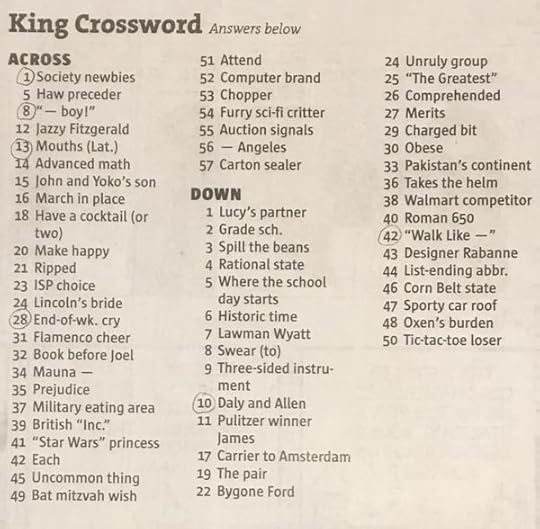
The musical group I couldn’t think of was, of course, Frankie Valli and the Four Seasons. D’oh. I also wanted to mention about the form of the clue matching the answer, that goes for names or locations as well. If the clue was “Jodie’s role in Silence of the Lambs” then you know it has to be CLARICE, the first name of her character as well. In the video I say that the thing that makes a puzzle easier or harder is the way the clues are written, which is true, but not the entire story. Often the harder puzzles will have longer words and barely any black spaces. That makes the puzzle harder too. I talk about the clues that end in question marks, signifying a pun or joke of some kind. Those are some of my very favorite clues. I’ll often laugh out loud when I get the answer. Playing with language is probably the best part of solving crosswords.
The next one is from the Super Crossword. Related to “Gigi” in 21-Across that I talked about is “No, mein Herr” in 105-Across. That’s going to be “Nein.” Even if you don’t speak German you know they’re looking for the German word for “No.” Or “Pedro’s year” is going to be “Ano.” There’s not much room to write clues so they use shorthand like this, even though foreign words are kind of iffy for constructors. The general rule is that they have to be fairly common in usage for English speakers, or at least something you’d learn in a first year foreign language class. One thing I forgot to say is if a word is in a clue, it won’t be part of the answer. Like 67-Across is “folk knowledge.” The answer absolutely won’t be FOLKLORE. If the clue is “Puts thru beta testing,” the answer won’t be TESTS. That’s often handy information to have.
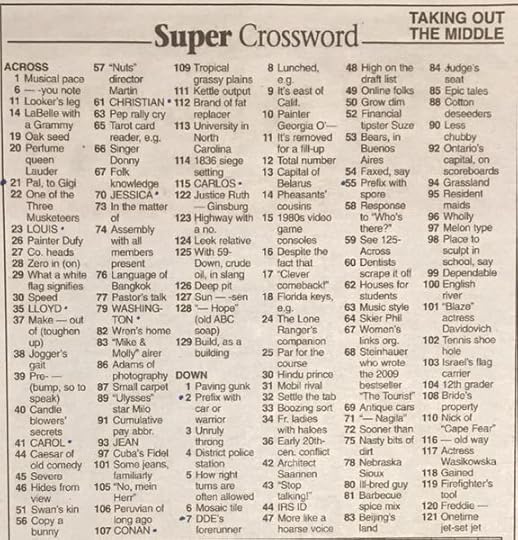
The third video is from a Monday New York Times crossword.

I didn’t explain that 9-Across [oh well] clue very well in the video. When you have quotations around a clue, that means it’s something someone would say. (Of course, if the quotation marks are around capitalized words, then you know it’s a title.) But when you have brackets around a clue, that means it’s something unspoken. [Oh well] is what you mean when you sigh, so the answer would be SIGH. If the clue was [Hey, buddy], the answer might by PSST because that’s the noise you make when you beckon someone. The brackets are the clue inside the clue.
After I did the video, I completed the puzzle and wanted to show you the clever theme we talked about with 57-Across, the “revealer” clue. You can see the answer to 57-Across is JUSTAPHASE. Now look at the hints the revealer points you to … GAS, SOLID, PLASMA, LIQUID. They’re all JUSTAPHASE of matter. See how themes and revealers work? Fun, right? Not every puzzle has a theme, and not all theme puzzles have revealer clues, but you know them when you see them!
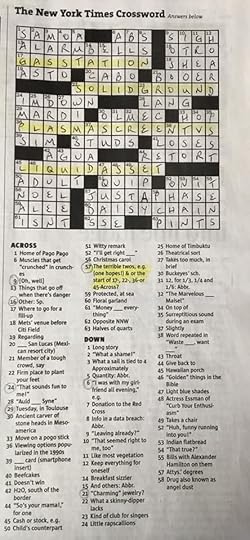
And the last video is from the much more difficult Sunday New York Times crossword.

I don’t have anything else to add to the video commentary except … don’t be afraid of crossword puzzles! They are excellent ways to keep mentally sharp because you’re joining up new synapses in your brain every time you see a common word in a new light or you learn a new word.
If you’re just beginning, use a pencil and erase as much as you need to. I go through and fill in all the answers I know, across and down. When you go back to the beginning, words will have begun to take shape. One thing I’ve learned not to do is take a wild stab and write it in because then that becomes all you can see for that entry. Hold back if you can until you get more squares filled in. If you have to walk away from the puzzle, do so! Your subconscious continues to work on the puzzle and when you come back, you’ll probably have more than one “Duh!” moment.
As you gain confidence and skill, try using pen. If you think you know 1-Across, get in the habit of mentally checking with the Downs to see if it fits. If one or more Downs agree, go ahead and ink it in … you’re probably right!
I’d love it if you’ve never done a crossword before to at least try one of mine. I’ll be the first to admit I’m not the world’s best constructor, but I get a tad better with each puzzle. (I wrote a post about constructing puzzles, and all the mistakes and tribulations I encounter.)
If, on the other hand, you like working crossword puzzles, and want to be one of my crossword testers, just email me!
So tell me … are you a fan of crosswords? Hate ’em? Never done one? Did you just need a nudge to send you into the deadly and treacherous* world of word games and now you’re a hopeless word junkie always jonesing for your next fix?
*not deadly or treacherous
October 20, 2020
How to Create a Crossword Puzzle
***SPOILER ALERT***
If you want to do the Fictional Female Sleuths puzzle before I talk about how I constructed it, stop right now and go to the puzzle page then come back here and read about it.
All constructors—even me—start by deciding on a theme. Admittedly, I don’t have to do this very much because the “themes” for my puzzles in the Crossword Mysteries are always clues from the actual book itself, whatever Quinn wants to subliminally plant for the chief of police.
Here’s an example of a more elaborate theme.
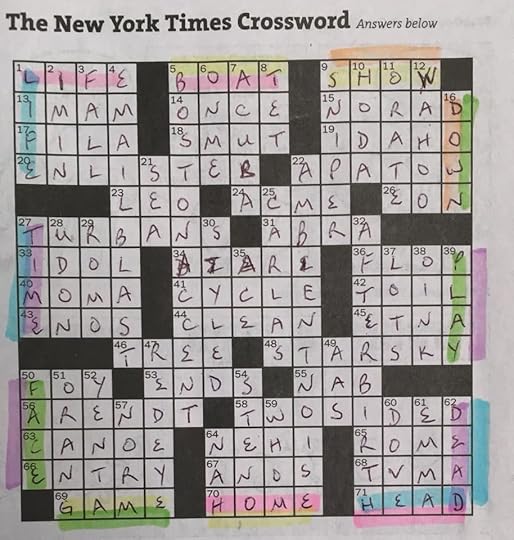
LIFEBOAT, BOATSHOW, SHOWDOWN, DOWNPLAY, etc
But for our purposes today, let’s say my theme will be Fictional Female Detectives. It’s not a very complex idea, but I’m not a very complex constructor.
I start by brainstorming a list of sleuths. Then I go back and count the letters for each entry.
I cross off the 16s because they won’t fit in my 15×15 grid. *taps temple to show I’m a thinker* I cross off the 13s because those are almost impossible to work with because of the symmetry of the puzzle. I cross off the 9s because they’re a little short and probably won’t stand out as theme entries. I cross off the lone 10 because I don’t have a mate for it. (I could keep brainstorming to find another 10-letter sleuth, but I have plenty of 12s.)
Jane Marple (10) Nancy Drew (9)Aurora Teagarden (15)Kinsey Milhone (13)Trixie Belden (12)Vera Stanhope (12)Precious Ramotswe (16)Stephanie Plum (13)Jessica Fletcher (15)Veronica Mars (12)Clarice Starling (15)Phryne Fisher (12)Quinn Carr (9)Charlemagne Russo (16)
I’m looking for symmetrical lengths. In my relatively easy puzzles, I can have one 15-letter entry right in the center. But I’m looking at those four 12s and digging on them. I won’t use a 15, just the 12s.
So here’s my final list:
Phryne Fisher (12)Trixie Belden (12)Veronica Mars (12)Vera Stanhope (12)
Now I open up a new grid in my Crossfire program and place these four theme entries. I place black squares at the end of PHRYNE FISHER and the program automatically places the corresponding three black squares to maintain symmetry. That’s where I type in TRIXIE BELDEN. Then I do the same with the other two entries.
There’s absolutely no reason why I placed these where I did. It’s just a starting point. More experienced constructors can probably realize the potential pitfalls of placement before typing them in.
“Potential Pitfalls of Placement.” That’s going to be the title of my crossword constructor memoir – ha!
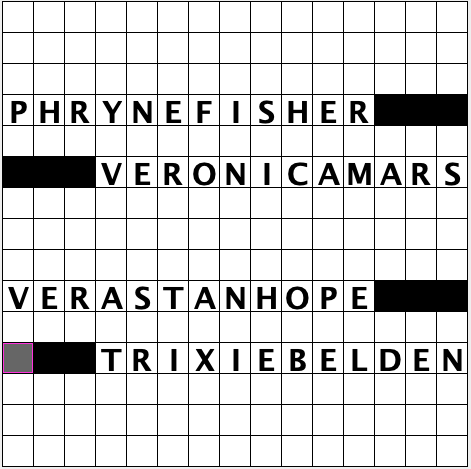
Now I try to figure out how to block off long spaces to make more manageable entries. This is absolutely trial-and-error—and tons of time—to get it where I’m happy. This is also where I can move the themes to different locations to see if they’d work better elsewhere.
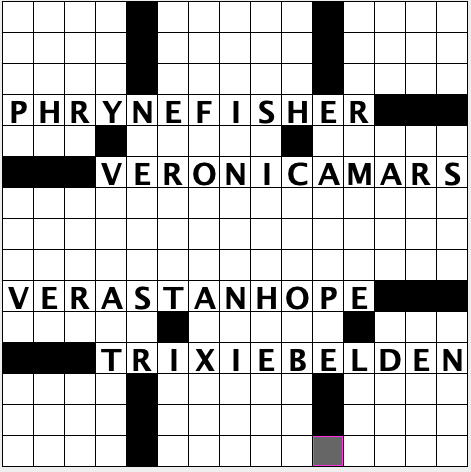
I picture which letters would end a word better. For instance, I put a spacer between the Y in PHRYNE and the V in VERONICA because I’d rather end a word in Y and begin one with V. My program tells me there are 431 words that end with Y that could fit there.
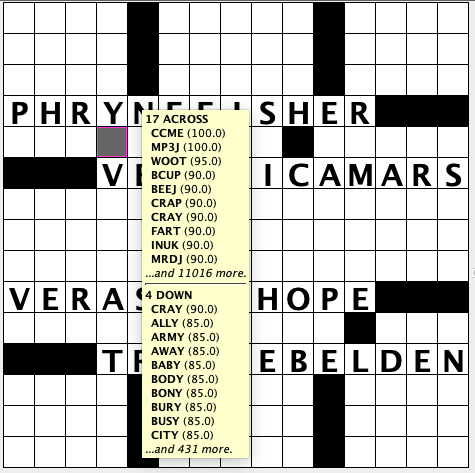
But if I move that black square below the V, I see there are only three possibilities for entries there. And they’re all bad, so I move the black square back where it was. Longer words are often more interesting, but not when they end in V!
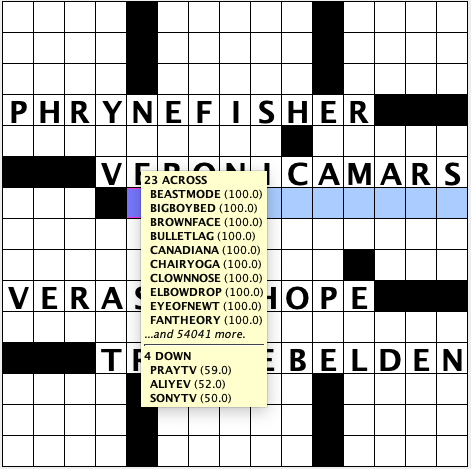
When I place my black squares I also have to be conscious of not making 2-letter words (which my program alerts me to), not having too many 3-letter words, and trying to keep to a maximum of 38 black squares.
This is the hardest and most frustrating part for me. I’ll keep track of the time and tell you how long it took to get a grid I’m happy with. The frustration comes in when I think I have a workable grid, but halfway through filling it with entries, I realize I’ve painted myself into some impossible situation and have to start over.
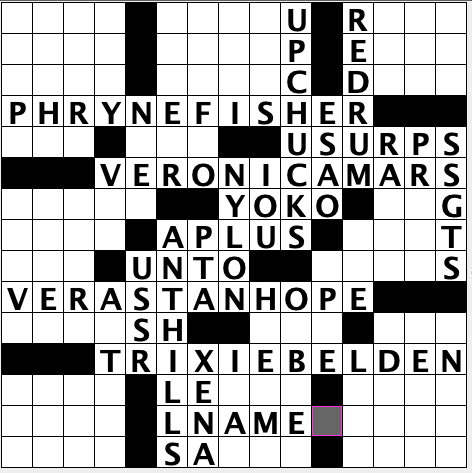
This took me 30 minutes. I started filling the grid before I really studied the grid. Rookie mistake. (And one I keep making. Sigh.) After I did all this, I saw the X in Trixie. Uh oh. Walk away, Becky. Just walk away.
After another 30 minutes the next day, I finally had to concede defeat, giving up on that grid. I moved my theme entries around. If I still have trouble, I can add a black square between the T in STANHOPE and the R in PHRYNE, which will also put a black square between the D in BELDEN and the C in VERONICA. The standard is to have no more than twenty 3-letter words, and by adding them, it would only bring me up to eighteen. But to lose my only 8-letter words would make me sad. Not sad enough not to do it if my frustration level threatens to smother me, mind you.
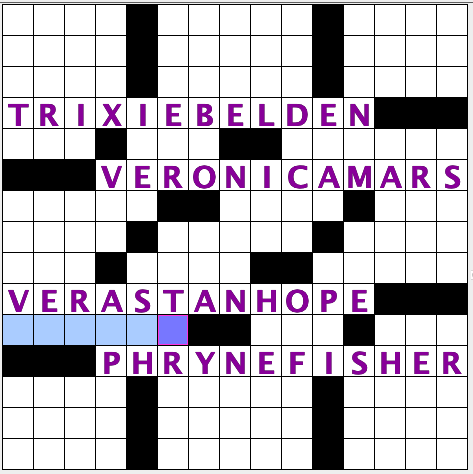
I could have gone back to my list of sleuths and chosen a 15-letter entry for the center of the puzzle, and just two of the 12-letter ones. But I chose to start over with the same four sleuths. This time, however, I decided on that X first thing. I probably shouldn’t have used TRIX and TRIXIE, but I really wanted a “silly rabbit” clue. There are many ways to fill that corner, so I’m not worried about the rest of it. But I am worried about that P in STANHOPE and that I in FISHER. OPTI is my only, ahem, option there. So I’m going to concentrate on this section to make sure I can get it to work.
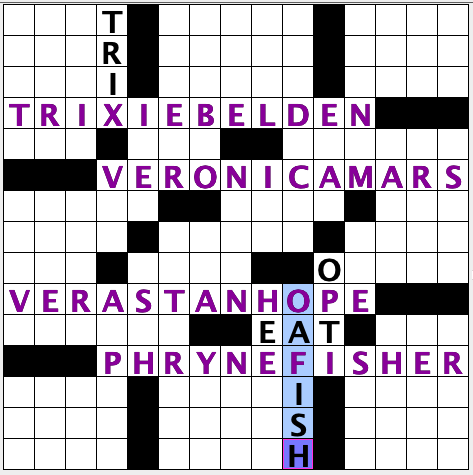
One hour and twenty-one minutes later. Frustrated. Had a snack. Came back. Switched my themers up. Twenty minutes later had this:
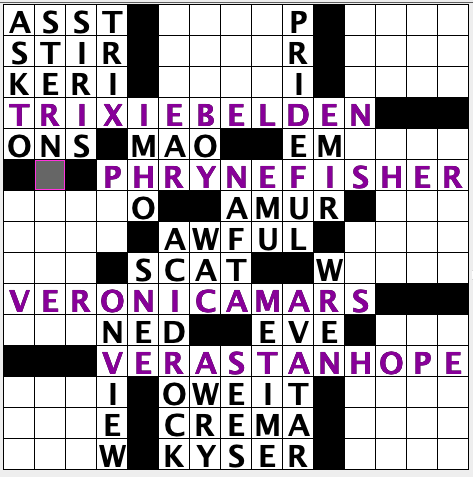
Back in the bad old days, constructors used pencil and graph paper to make puzzles. For fun [spoiler alert: it was decidedly not fun], I tried creating a puzzle by hand. How hard could it be, I scoffed. My conclusion was that it can be done—in the same way a novel can be written on a scroll of single-ply toilet paper—just not by me.
My computer program is robust. I’ve added a couple of dictionaries compiled by generous, more established constructors, so this is what I see when I’m attempting the fill.
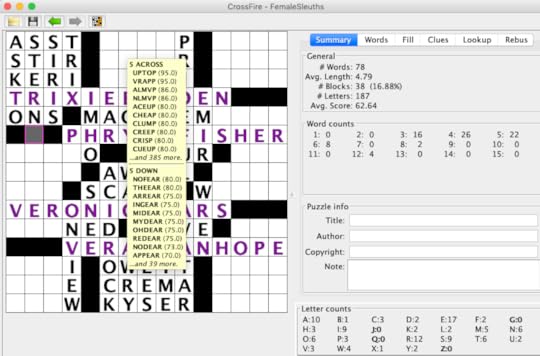
When I plant my cursor in the 5-Across/Down square, if I ask it to, it tells me all the possible words I can use. You’ll see there’s a score next to each word. The higher the number, the more that constructor/dictionary creator likes that word. There’s a big push these days to make puzzles more inclusive and up-to-date, using more words that will appeal to a broader swath of people. I don’t care much about my scores, though, because I’m not submitting my puzzles for publication anywhere but my books and website.
I use the list of potential words as my springboard. As I’m checking the viability of my grid, I’m hovering over the squares, making sure there’s a healthy list of words I can use. Earlier, when I painted myself in the corner with that X in TRIXIE, it’s because I failed to do this. I just got distracted by the cool fill elsewhere.
And then it’s just trial and error and choosing words that please me. It broke my heart when I had to give up on that grid earlier because I was going to use REDRUM in there. How awesome is that?? Now to my dying day I’ll be looking for a way to get REDRUM into a puzzle.
You can also see the rest of the page I get as I work. It shows me how many words and black squares in my puzzle. Because I’m such a novice, I’m stepping a bit over the maximum number of blocks (40 instead of 38), and I’m at the max for number of words (78). It also shows me how many of each letter of the alphabet I’ve used. I try to use at least one of everything, but that’s not a deal-breaker for me. I’m just worried about getting a solid fill. I’ve heard more experienced constructors say it’s perfectly fine to bend the rules to get a better puzzle, so I’ve taken that advice to heart. It has saved my sanity plenty of times.
It’s been another two hours and I finally got the upper center section filled. But I’m not happy with it because it has what’s known in the crossword biz as some “dirty double crossers.” All three of those red boxes are obscure proper names, so you’d have to know them in order to solve the puzzle. You could maybe get them elsewhere in the puzzle if you didn’t actually know the person, but not when they all cross like that.
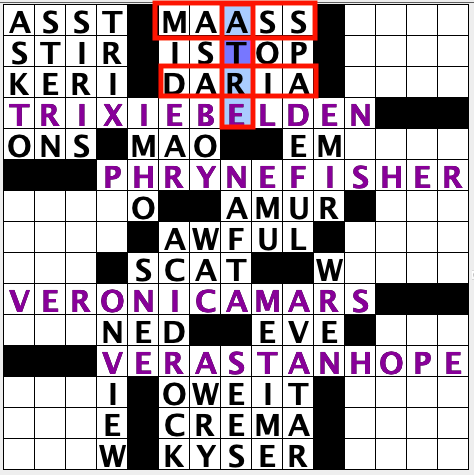
So my decision here is to keep trying or undo SPADEFUL and everything that entails.
The hard part about sticking with it, is that MAO can be MEL or MAL or MEN or MAN or MEA or MIA … which means MIDEAR and ASABOY can change in myriad ways. And SPADEFUL can be PRIDEFUL, so the combinations are complicated. It’s like scientific testing. You try to only change one variable at a time, but here, every variable you change has ramifications you can see immediately.
But I’ve spent all morning on this, so I’m going to have my lunch.
Twenty minutes after lunch I had this.
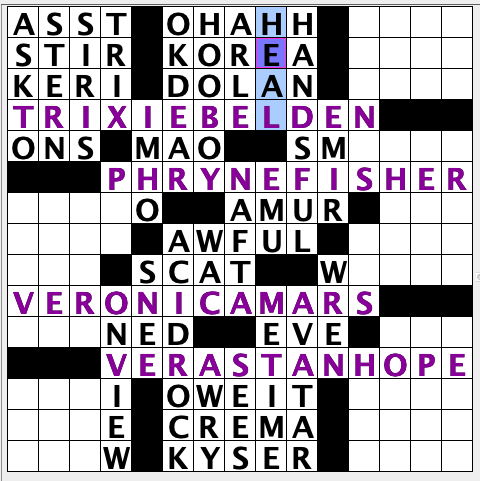
Still not completely happy with it, but it’s much better than before. There’s no way I’d submit this to the NYT, but for my purposes I can make it work. Onward.
It took me forty-five minutes to finish the rest of the entries.
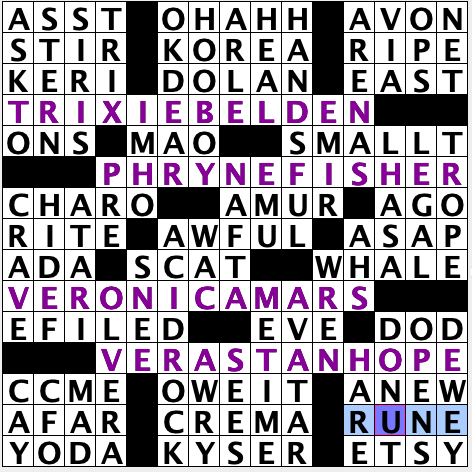
It’s not the best puzzle I’ve made, but it is the best one I can make with this grid and these theme entries.
Now comes the fun part … writing the clues. When I’m filling the grid, I often choose words based on a cool clue that pops into my head. That’s why SMALLT and CCME and METIME are in this puzzle. And TRIX.
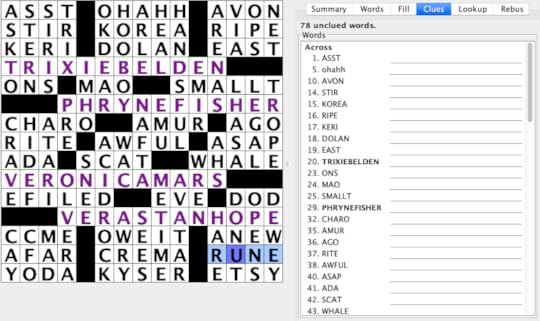
Writing the clues is just as it sounds. I type them right in that space, making sure I capitalize properly, abbreviate as necessary, spell correctly, fact check, have usage agreement between the clue and the entry (if the entry ends in ED, then my clue better be past tense, for instance), and I have to consider the difficulty of the puzzle. I try to keep mine in the middle somewhere—not too easy for experienced puzzlers, but not too hard for novices. I rely on my testers to tell me if I hit the mark or made any mistakes. They’re like the beta readers for my novels. I think this one is kind of on the more difficult side, though.
Unfortunately for me, sometimes I find problems when I’m cluing. In Fatal Solutions, book #3 in the Crossword series, I was caught in the crosshairs of a deadline. I can’t make the puzzles for the books until the books are finalized in case pertinent facts or suspects’ names change. So I was working like mad to get a good puzzle to my editor before my deadline and was so thrilled when I realized it would happen. Until I was cluing, that is, and realized I’d used the word TRADE twice in the puzzle! That would never fly in the professional world of puzzles, but in my books I get to do whatever I want (remember, my sleuth Quinn is actually the constructor so I rely on her good judgment). Quinn told me to relax and keep them both, just write funny clues for them. So I clued one as “swap,” and the other as “if you swap this for 54-Down, you get the same thing!” It made my testers laugh, so that was good enough for me. Who needs a bunch of humorless automatons working my puzzles??
After I get feedback from my testers, I make whatever tweaks they point out, and then I stick a fork in it because it is DONE.
So that’s all there is to it! Makes you want to start constructing, I bet ….
How’d you do on the Fiction Female Sleuth puzzle? Did you find it easy? Hard? In between? Did you find any mistakes?
September 28, 2020
“I’m So OCD”
Have you ever heard someone say, “I’m so OCD” when they do something perfectly reasonable like fold their towels a particular way (in my case, so they fit on the shelf), or park in the same aisle of the grocery store lot (in my case, so I can one, find my car, and two, not have to wait for pedestrians), or drink the same cocktail from the same glass (in my case, because I love gin-and-gingers and my Denver Broncos cup is big and opaque enough nobody really knows how much I poured)?
Well, I’ve got news for you. None of that indicates Obsessive-Compulsive Disorder.
The hallmark of OCD is unreasonable fear that leads to obsessive behavior. If you suffer from OCD and your towels aren’t folded a particular way you might feel an unnamed dread that you can’t shake. If you travel down the “wrong” aisle of the parking lot, you may have to stop and drive in reverse all the way out because your fear of hitting a pedestrian is overwhelming and very, very real. If someone hands you a cocktail in something other than your orange Broncos cup, you won’t be able to drink it for reasons you aren’t even aware, or worse, reasons that sound so ridiculous they make you ashamed.
A friend of mine diagnosed with OCD took exception to a joking “I’m so OCD” comment she heard. I’ve said it and heard it many, many times and never really thought about how it might sound to someone who has actually been diagnosed with OCD.
This isn’t to say that the people I know who have OCD don’t have delightful senses of humor about their challenges … quite the contrary! Some of the stories they told me on themselves were hilarious. I suppose it’s the same way I can joke about my chin hairs, but if you do, it will make me crawl under the covers and eat ice cream for three weeks straight.
At any rate, it all got me thinking about a cozy mystery series set in the world of crossword puzzles I’d been cogitating over. I knew my protagonist was going to create crosswords—and I’d have to learn—but that’s about all I knew. The more I thought about it though, the more it made sense that someone with organizational OCD would really excel at something like constructing crossword puzzles.
Thus was born Quinn Carr.
The perfection of a pristine crossword puzzle grid always made Quinn Carr’s pleasure center buzz. The puzzle was orderly. Symmetrical. No chaos. No mess. No negotiation. Only one correct answer. A puzzle grid never looked at you funny when you agonized over some marketing sociopath who couldn’t understand that “pepper, black” was worlds apart from “black pepper.” Crossword puzzles never judged you.
Because I don’t have OCD, the crossword creation comes harder for me than for Quinn, but when I get a pristine grid, I get a bit of a buzz too. I never thought constructing crosswords would be easy, but I also never thought it would be so pull-out-your-hair-and-quietly-weep-in-the-corner frustrating either, despite using robust software that handles rotational symmetry and provides extremely useful hints about possible entries that could fill the grid.
I find the task of creating original crosswords for the Crossword Mystery series and for marketing/promotion much more difficult than writing the books. I console myself that at least, unlike Quinn, I don’t have to create them as subliminal messages to prod the crossword-loving chief of police to investigate crimes he’d rather sweep under the rug.
Oh, wait. Yes I do. Dang it.
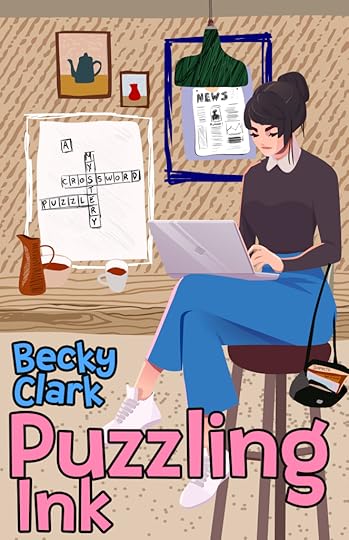 Puzzling Ink is on NetGalley and up for preorder.
Puzzling Ink is on NetGalley and up for preorder.Will you think twice about declaring, “I’m so OCD” in the future? What’s your relationship like with the venerable crossword puzzle? Are you intimidated by it? Don’t see the point of crosswords? Or have you conquered their complexities and relish every challenging clue? Do you do the Sunday NYT in ink?
September 17, 2020
Hey baby, come here often?
I’m not a photographer, but I can picture us together.
Are you religious? Because you’re the answer to all my prayers.
Do you know what my shirt is made of? Boyfriend material.
Even if there wasn’t gravity on earth, I’d still fall for you.
Are you a parking ticket? ‘Cause you’ve got fine written all over you.
Not gonna lie. Back in the day, these pick-up lines would probably have worked on me. Yes, they’re cheesy, but they immediately tell me something about my future paramour. He or she is funny. And funny is the golden ticket for me.
Opening lines in books do the same thing.
A good opening sets the stage for everything that happens next. It gives you a glimpse of the character you’ll be traveling with on this 300-page journey. It gives you a hint of where and when you are. It lets you know whether you’re going to laugh, or be terrified, or skeeved out … or all of the above.
A REALLY good opening does all that in the first sentence. As you can imagine, that’s quite difficult.
So let’s take a trip to my local literary bar and do some speed dating.
Here are your potential suitors. They’re on their best behavior, wearing their spiffiest clothes and smelling marvelous. Let’s hear what they have to say to woo you.
THE HIGHWAYMAN – Craig Johnson
There is a canyon in the heart of Wyoming carved by a river called Wind and a narrow, opposing, two-lane highway that follows its every curve like a lover.
THE BLACK WIDOW – Wendy Corsi Staub
“Some things,” Carmen used to say, “just don’t feel right until the sun goes down.”
THE SEMESTER OF OUR DISCONTENT – Cynthia Kuhn
When summoned by the department chair, one shows up on time.
BLOOD ON THE TRACKS – Barbara Nickless
His life wasn’t worth spit in a hard rain.
TREBLE AT THE JAM FEST – Leslie Budewitz
Blame it on the rhubarb.
DESIGNER DIRTY LAUNDRY – Diane Vallere
When you wear fishnet stockings to the grocery store, people tend to stare.
CLASS REUNIONS ARE MURDER – Libby Klein
I was being bullied by stationery.
HUNTING HOUR – Margaret Mizushima
“Whom do you trust, Maddie?”
FICTION CAN BE MURDER – Becky Clark
Melinda Walter settled her lean Pilates body—the maintaining of which took all her free time and could fund North Korea’s military for a year—into the soft leather driver’s seat of her sleek red 1959 classic Corvette.
BANANA BAMBOOZLE – Becky Clark and Ted Hardwick
Using only one hand, Cassidy Dunne silently unwrapped a fun-size Snickers hidden in her sundress pocket.
These are just a few individuals loitering against the wall near my neighborhood office. Would you enjoy spending more time with them? Grab them and steal away to a quiet corner where you can be alone? Take them to bed? (You vixen, you.) Which made your heart go pitty-pat? Is your heart already taken by another? Are you willing to share?
Do you feel jilted by this metaphor yet?



